
Film Study: Finding the right fit for Jarrett Stidham, Auburn’s missing link
By Matt Hinton
Published:
For all his gifts, for all the potential, there remained a nagging sense following Jarrett Stidham’s commitment to Auburn last winter that perhaps the former Baylor transfer isn’t the most natural fit for Gus Malzahn’s offense at Auburn. True, even without an extensive résumé Stidham passed all of the fundamental test for a high-level prospect in spades. The size, the arm, the 5-star pedigree: Check, check and check. A breakout performance in the spring, fueling premature Heisman hype in the summer: More checks. And heaven knows, if anyone knows how to fit a talented transfer into the existing structure of his offense, it’s Malzahn.
Still, although he’s a prototypical talent in other ways Stidham seemed to defy the template of the ideal Malzahn QB: Despite his pass-happy roots in the high school ranks, Malzahn’s decade-long tenure at Auburn as a head coach and offensive coordinator has been defined by his wild success with a pair of dynamic runners behind center, Cam Newton and Nick Marshall, and his failure to generate anywhere near the same returns with anyone else. At their best, the Tigers are a spread-to-run outfit that puts the quarterback’s athleticism front and center and builds the rest of the system, passing game included, off that foundation. Nothing we know about Stidham suggests he’s that guy.
And within the context of Malzahn’s playbook, if he’s not that guy, then who is he? Auburn’s opener, a run-oriented, 41-7 romp over Georgia Southern, didn’t go very far in providing an answer, in large part because it didn’t have to. This weekend’s above-the-fold trip to No. 3 Clemson, on the other hand, stands to tell us everything we need to know — about Stidham, about the flexibility of Malzahn’s system, and about whether the marriage between quarterback and scheme is on firm enough ground to support a sustained playoff run. If the chemistry is right, it’s not difficult to imagine Auburn staking its claim on Saturday as a legitimate dark horse. If it’s not, the offseason hype could turn very sour, very fast.
The Long and Short of It. There’s very little doubt about Stidham’s capacity to challenge opposing secondaries deep, which he showed off at every opportunity in his brief stint as Baylor’s starter, in 2015, and in Auburn’s spring game, where he effectively clinched the starting job on the strength of several well-placed bombs. In the season opener against Georgia Southern, not so much: None of his 14 completions gained more than 19 yards, and all but two targeted receivers within 7 yards of the line of scrimmage. The majority of Stidham’s output for the night came after the catch, on an assortment of screens and crossing routes.
And against tomato can from the Sun Belt, that was fine — Auburn basically ran at will on GSU’s overmatched front, relegating the passing game to more of an accessory, anyway. Even within that limited role, Stidham demonstrated some tangible growth between the first quarter, when he threw his first interception as a Tiger in the face of a six-man rush on 3rd-and-9 …
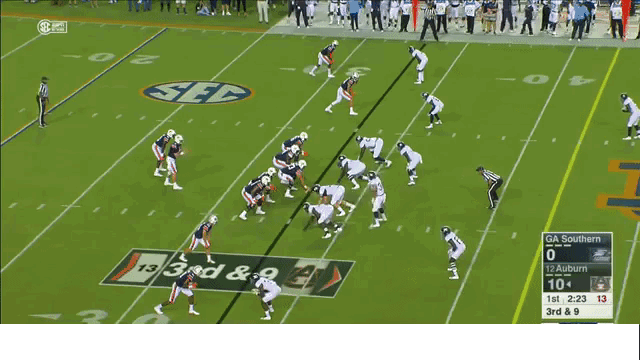
… and the third quarter, when he faced an almost identical all-out blitz on 3rd-and-6. This time, Auburn exploited the Eagles’ aggression with a simple rub route that freed up the outside receiver, Kyle Davis, into the area vacated by the blitzing linebackers. The result: Stidham’s first touchdown pass as a Tiger, a 19-yard, catch-and-run score by Davis on a ball that traveled approximately 2 yards across the line of scrimmage:
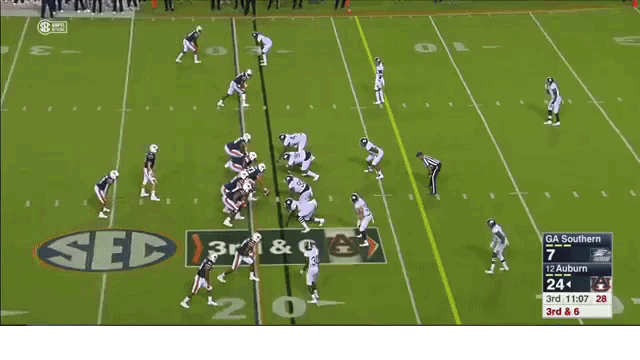
If any single play offered a glimpse of Stidham’s potential in Malzahn’s system, though, it was his second TD pass, his most impressive throw of the night by far. Like so many of Malzahn’s big-play shots, that play was set up by Auburn’s dominant effort on the ground, generally, and specifically by pre-snap motion into the backfield by No. 12 Eli Stove, who (as Georgia Southern was no doubt very acutely aware) took a jet sweep 78 yards for a touchdown in last year’s blowout win over Arkansas.
This call came on 1st-and-10, an obvious run down, and the mere threat of Stove taking a handoff around the edge forced the safety to the weak side of the formation, No. 24 Sean Freeman, to creep into the box as a contain player; that rendered Freeman practically useless against any kind of downfield pass, leaving the cornerback to his side of the formation on an island against wide receiver Will Hastings, No. 33, with no safety help.
Stidham, with time in the pocket and a favorable matchup in the end zone, stepped up and dropped a ball over Hastings’ shoulder that looked like it was guided by the exact coordinates of Hastings’ hands:
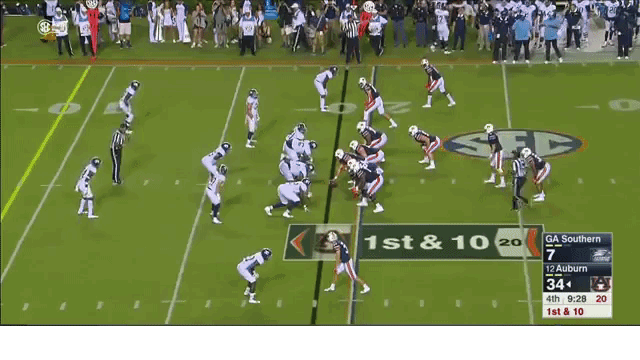 Tomato can or not, that play was encouraging for a lot of reasons, most obviously because it was the first proof of the golden arm Auburn fans have been envisioning for the past nine months. (The emergence of Hastings, who arrived at Auburn as a walk-on kicker, as potentially the most reliable option in an otherwise blue-chip receiving corps was a notable development, as well; all four of his receptions against GSU gained at least 15 yards.) But the concept itself — using pre-snap motion to momentarily freeze safeties in no man’s land, allowing a receiver to run by them vertically — is a Malzahn staple over the years, one he’s returned to frequently out of a variety of formations.
Tomato can or not, that play was encouraging for a lot of reasons, most obviously because it was the first proof of the golden arm Auburn fans have been envisioning for the past nine months. (The emergence of Hastings, who arrived at Auburn as a walk-on kicker, as potentially the most reliable option in an otherwise blue-chip receiving corps was a notable development, as well; all four of his receptions against GSU gained at least 15 yards.) But the concept itself — using pre-snap motion to momentarily freeze safeties in no man’s land, allowing a receiver to run by them vertically — is a Malzahn staple over the years, one he’s returned to frequently out of a variety of formations.
In fact, the same basic idea accounted for Auburn’s only big play against Clemson in 2016, a 43-yard heave from Sean White to then-true freshman Kyle Davis in the fourth quarter:
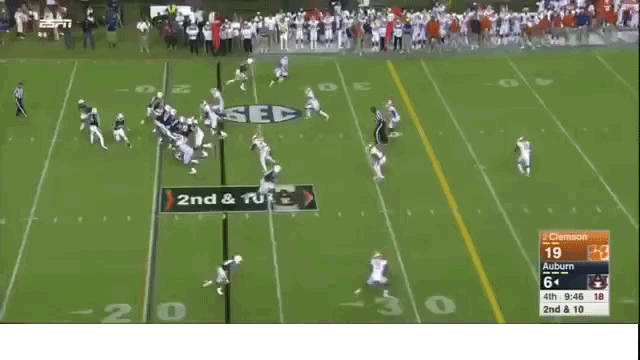 I’m pulling these clips from the TV broadcast, which unfortunately just missed the pre-snap gadgetry on this one. (Fewer extended close-ups on defensive linemen in their stances, please, thank you.) But the end zone angle gives us a better picture of just how severely the middle safety in Clemson’s three-deep zone, No. 18 Jadar Johnson, overreacted to the threat of the motion receiver keeping the ball on an end-around, leaving him badly out of position as Davis streaked into the open field:
I’m pulling these clips from the TV broadcast, which unfortunately just missed the pre-snap gadgetry on this one. (Fewer extended close-ups on defensive linemen in their stances, please, thank you.) But the end zone angle gives us a better picture of just how severely the middle safety in Clemson’s three-deep zone, No. 18 Jadar Johnson, overreacted to the threat of the motion receiver keeping the ball on an end-around, leaving him badly out of position as Davis streaked into the open field:
 This was both Auburn’s best offensive play of that game and the one that most clearly exposed the limits of White’s pedestrian arm strength. (In fairness, White was forced to readjust his feet just before he let the ball go and couldn’t step into the throw as fully as he would have liked due to pressure from Clemson’s front four — always a significant risk of trying to go deep against Clemson with any frequency. The Tigers’ defensive line remains absolutely loaded, and under defensive coordinator Brent Venables they’ve consistently finished as one of the most sack-happy teams in the nation.) Davis was open; a throw that hits him stride might have gone for a touchdown, which to that point Auburn hadn’t come close to scoring. Instead, the Tigers bogged down and came away empty after turning the ball over on downs.
This was both Auburn’s best offensive play of that game and the one that most clearly exposed the limits of White’s pedestrian arm strength. (In fairness, White was forced to readjust his feet just before he let the ball go and couldn’t step into the throw as fully as he would have liked due to pressure from Clemson’s front four — always a significant risk of trying to go deep against Clemson with any frequency. The Tigers’ defensive line remains absolutely loaded, and under defensive coordinator Brent Venables they’ve consistently finished as one of the most sack-happy teams in the nation.) Davis was open; a throw that hits him stride might have gone for a touchdown, which to that point Auburn hadn’t come close to scoring. Instead, the Tigers bogged down and came away empty after turning the ball over on downs.
Here’s what the same concept looks like with a 5-star arm and decent protection, from the second play from scrimmage in the 2010 SEC Championship Game:
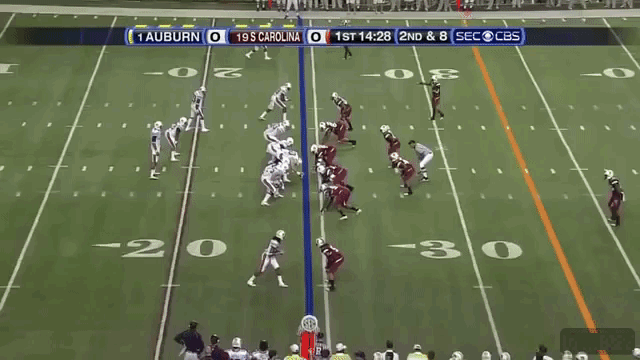
Sixty yards, in stride. The trailing cornerback on that play, Stephon Gilmore, was a future first-round draft pick who’s now entering his sixth year as a full-time starter in the NFL; against just about any other college corner, that’s six. (That Auburn team quickly turned it into six, anyway, and the rout was on.) After the new quarterback, Clemson’s corners will open Saturday’s game as arguably the biggest question mark on the team.
Now, it goes without saying that you should not expect to wake up Sunday morning entertaining the notion that Jarrett Stidham is the second coming of Cam Newton. But he is the first quarterback at Malzahn’s disposal since Cam who is conceivably a threat to deliver that kind of throw with some consistency. At minimum opposing secondaries will have to respect that threat, or risk paying for it severely. Given all the other aspects of Auburn’s attack they’re forced to respect already, a quarterback who can land a knockout at any moment amid of steady diet of body blows is a game-changing prospect.
To Run, Or Not to Run. On the other side of the coin, it’s not clear yet how much attention Stidham will draw in the option game. So much of Malzahn’s scheme — in the running game and passing game alike — hinges on forcing defenses to account for his quarterback as a runner, or at least as a potential runner, that abandoning the option-oriented elements in the playbook is probably impossible. But that doesn’t mean defenses will necessarily fear the option, which was a major element missing the past two years with White taking the majority of the snaps. Just how much of an upgrade Stidham represents on that front is an open question.
It’s not that Stidham can’t move: He was generally categorized as a “dual threat” quarterback by the recruiting sites, and flashed some impressive mobility early in the Georgia Southern game as a scrambler. He kept the ball on a handful of read-option looks, and scored in the second quarter on what was essentially a triple-option keeper, with the back motioning into the flat as a receiver in place of the traditional pitch man:
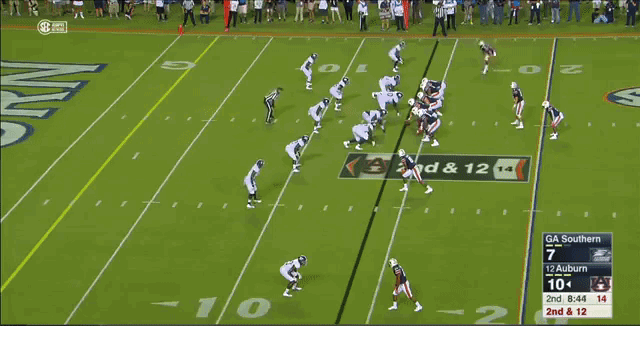 Altogether Stidham recorded six carries for 29 yards, not including sacks, which suggests he’ll have a prominent role in that part of the offense, if not nearly to the extent of a Marshall. (In his two seasons as QB1 Marshall averaged a little more than a dozen carries per game.) He’s not likely to hit the accelerator from 40 yards out, but at 6-3, 214, he certainly has the frame to withstand a pounding on third-and-short if necessary.
Altogether Stidham recorded six carries for 29 yards, not including sacks, which suggests he’ll have a prominent role in that part of the offense, if not nearly to the extent of a Marshall. (In his two seasons as QB1 Marshall averaged a little more than a dozen carries per game.) He’s not likely to hit the accelerator from 40 yards out, but at 6-3, 214, he certainly has the frame to withstand a pounding on third-and-short if necessary.
But just how necessary it will be to keep him involved as a runner on a down-to-down basis is a different question. With Marshall, or Jeremy Johnson, it was essential; their mobility was the asset that helped unlock the rest of the offense. With Stidham, it’s the opposite — defenses clearly have more reason to fear his arm than his legs. That can work in his favor as far as opening up larger running lanes, but it also raises the cost of the hits he’ll endure in the process. Why expose a prized passer for relatively incremental gains on the ground? Just how Malzahn decides to answer that question against Clemson will tell us a lot about Stidham’s role, specifically, and what the offense as a whole will look like over the course of the season.
To Saturday and Beyond. It’s rare for a game in early September to carry so much weight, but it’s also rare for a team with Auburn’s expectations to have so much riding on a player who’s played as little at the D-I level as Stidham. On paper, Auburn is loaded with proven playmakers in the backfield (Kamryn Pettway, Kerryon Johnson, Kam Martin in a pinch) and a crowded lineup of promising up-and-comers at receiver (Hastings, almost literally everyone else). The offensive line projects as a strength. The overall talent level isn’t in doubt; the coaching staff has a proven track record. The only missing piece from that equation is the quarterback.
If Stidham is the link between a borderline top-20 outfit and a legitimate Playoff contender, it’s hard to imagine a more challenging or appropriate stage on which to prove it. In Auburn’s four regular-season losses last year, it failed to top 16 points in any of them yet remained competitive well into the fourth quarter of all four; in the down-to-the-wire slugfests against Clemson and Georgia, especially, even a modicum of consistency behind center might have tipped the scoreboard in the Tigers’ favor.
Stidham’s commitment in December allowed everyone in the program to imagine what could have been and what might be, visions that have been playing in their head ever since. Finally, Saturday night is an opportunity to see what the future looks like for real.
Matt Hinton, author of 'Monday Down South' and our resident QB guru, has previously written for Dr. Saturday, CBS and Grantland.







